Related Research Articles

Humboldt is a city in Allen County, Kansas, United States. It is situated along the Neosho River. As of the 2020 census, the population of the city was 1,847.
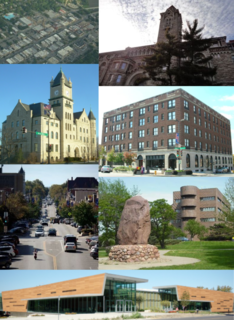
Lawrence is the county seat of Douglas County, Kansas, United States, and the sixth-largest city in the state. It is in the northeastern sector of the state, astride Interstate 70, between the Kansas and Wakarusa Rivers. As of the 2020 census, the population of the city was 94,934. Lawrence is a college town and the home to both the University of Kansas and Haskell Indian Nations University.

Quantrill's Raiders were the best-known of the pro-Confederate partisan guerrillas who fought in the American Civil War. Their leader was William Quantrill and they included Jesse James and his brother Frank.
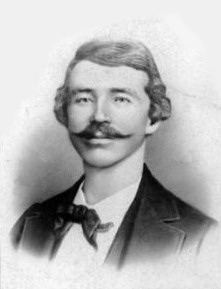
William Clarke Quantrill was a Confederate guerrilla leader during the American Civil War.

James Henry Lane was a partisan militia leader during the Bleeding Kansas period that immediately preceded the American Civil War. During the war itself, Lane served as a United States Senator and as a general for the Union. Although reelected as a Senator in 1865, Lane committed suicide the next year.

The Lawrence Massacre, also known as Quantrill's raid, was an attack during the American Civil War (1861–65) by Quantrill's Raiders, a Confederate guerrilla group led by William Quantrill, on the Unionist town of Lawrence, Kansas, killing around 150 unarmed men and boys.
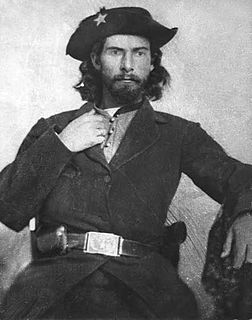
William T. Anderson, known by the nickname "Bloody Bill" Anderson, was an American soldier who was one of the deadliest and most notorious Confederate guerrilla leaders in the American Civil War. Anderson led a band of volunteer partisan raiders who targeted Union loyalists and federal soldiers in the states of Missouri and Kansas.

The sacking of Lawrence occurred on May 21, 1856, when pro-slavery settlers, led by Douglas County Sheriff Samuel J. Jones, attacked and ransacked Lawrence, Kansas, a town which had been founded by anti-slavery settlers from Massachusetts who were hoping to make Kansas a free state. The incident fueled the irregular conflict in Kansas Territory that later became known as Bleeding Kansas.
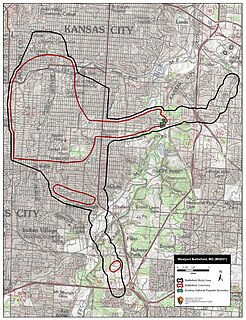
The Battle of Westport, sometimes referred to as the "Gettysburg of the West", was fought on October 23, 1864, in modern Kansas City, Missouri, during the American Civil War. Union forces under Major General Samuel R. Curtis decisively defeated an outnumbered Confederate force under Major General Sterling Price. This engagement was the turning point of Price's Missouri Expedition, forcing his army to retreat. The battle ended the last major Confederate offensive west of the Mississippi River, and for the remainder of the war the United States Army maintained solid control over most of Missouri. This battle was one of the largest to be fought west of the Mississippi River, with over 30,000 men engaged.

The First Battle of Independence was a minor engagement of the American Civil War, occurring on August 11, 1862, in the city of Independence, located in Jackson County, Missouri. Its result was a Confederate victory, continuing the Southern domination of the Jackson County area for a few days while the recruiters completed their work.

Bushwhacking was a form of guerrilla warfare common during the American Revolutionary War, War of 1812, American Civil War and other conflicts in which there were large areas of contested land and few governmental resources to control these tracts. This was particularly prevalent in rural areas during the Civil War where there were sharp divisions between those favoring the Union and Confederacy in the conflict. The perpetrators of the attacks were called bushwhackers. The term "bushwhacking" is still in use today to describe ambushes done with the aim of attrition.
The trans-Mississippi theater of the American Civil War was the scene of the major military operations west of the Mississippi River. The area is often thought of as excluding the states and territories bordering the Pacific Ocean, which formed the Pacific coast theater of the American Civil War (1861–1865).

At the outbreak of the American Civil War in April 1861, Kansas was the newest U.S. state, admitted just months earlier in January. The state had formally rejected slavery by popular vote and vowed to fight on the side of the Union, though ideological divisions with neighboring Missouri, a slave state, had led to violent conflict in previous years and persisted for the duration of the war.
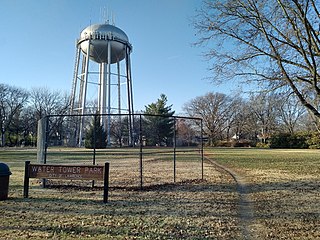
Lawrence, Kansas was not well defended in the early part of the Civil War. That ended with William Quantrill's devastating guerrilla raid August 21, 1863. By early 1864 Union soldiers were permanently camped on the top and slopes of Mount Oread, then to Lawrence's southwest. It seems the camp was originally named Camp Ewing, after Brig. Gen. Thomas Ewing.
Council Grove's Post is a trading post on the Santa Fe Trail that operated in Council Grove, Kansas. It was established around 1861 and decommissioned around 1864, with ties to the Civil War.
Fort Lane, on the crest of Mount Oread, then southwest of Lawrence, Kansas, was built by the residents of Lawrence in 1856 to serve as a lookout post to observe groups of men desiring to attack Lawrence. Lawrence was a free-state community built by northerners. From 1854 to 1861, when Kansas became a state, at times the area around Lawrence was a battleground for settlers who had come from both the northern and southern states. From this location, one could see for many miles in all directions.
Two structures in Lawrence have been known as the Lawrence Armory - the Civil War era armory and the Lawrence Kansas Army National Guard Armory.
Paola's post, sometimes called Post Paola, in Miami County, Kansas, was located on the west side of Bull Creek, just west of Paola, Kansas. It was probably established in December 1861, as that was the first time it was mentioned. This post became one of the more important posts along the Kansas-Missouri border during the Civil War. It became a district headquarters in 1863. Later, in September 1864, it was designated a subdistrict headquarters, when the district headquarters was moved to Lawrence, Kansas. The military road from Fort Leavenworth to Fort Gibson ran through Paola, thus ensuring the post always had some importance.
Franklin is a ghost town in Douglas County, Kansas, United States. Established as a proslavery stronghold, the town played a key role in the "Bleeding Kansas" conflict that troubled the territory in the 1850s.
Newell W. Spicer was a Union Army lieutenant colonel of volunteers during the American Civil War and a commander of the 1st Regiment Kansas Volunteer Infantry. He was also a leader of pro-abolitionist forces during Bleeding Kansas, a violent period in the history of Kansas when factions fought over proposals to abolish slavery in that state.
References
- ↑ Richard Cordley,A History of Lawrence Kansas (Lawrence: E. F. Caldwell, 1895), chapter XVII, paragraph 4 (in the Kansas Collection website, at http://www.kancoll.org/books/cordley_history/ ).
- ↑ Peter D. Ridenour,Quantrill's Raid: Aug. 21,1863 (Lawrence: Douglas County Historical Society, n.d.), pp. 26-7.
- ↑ William C. Pollard, Jr., "Forts and Military Posts in Kansas: 1854-1865" (Ph.D. dissertation, Faith Baptist College and Seminary, 1997), p. 145 (a copy is in the Kansas State Historical Society archives, Topeka, Kans.).
- ↑ Cordley, chapter XVII, paragraph 17.
- ↑ Ridenour, pp. 26-7.
- ↑ Capt. R. D. Mobley, report, The War of the Rebellion (Washington: Government Printing Office, 1893), Series I, Vol. XLI, Part IV, p.167.
- ↑ Cordley, chapter XVIII, paragraph 17.
- ↑ Ridenour, pp, 26-7.